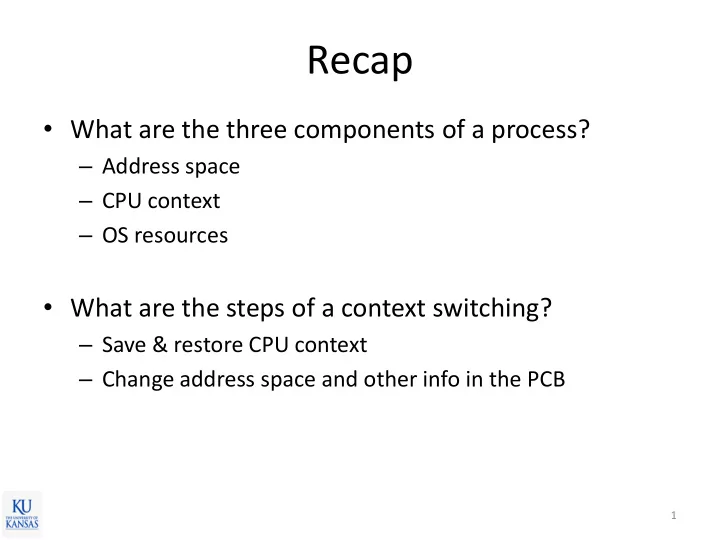

Recap • What are the three components of a process? – Address space – CPU context – OS resources • What are the steps of a context switching? – Save & restore CPU context – Change address space and other info in the PCB 1
Process Creation • UNIX examples – fork() system call creates a new process, which is a copy of the parent process – exec() system call used after a fork() to replace the process ’ memory space with a new program 2
Example: Forking a Process in UNIX Child Parent 3
Example: Forking a Process in Windows 4
Process Termination • Normal termination via exit() system call. – Exit by itself. – Returns status data from child to parent (via wait() ) – Process’s resources are deallocated by operating system • Forced termination via kill() system call – Kill someone else (child) • Zombie process – If no parent waiting (did not invoke wait() ) • Orphan process – If parent terminated without invoking wait – Q: who will be the parent of a orphan process? – A: Init process 5
Mini Quiz • Hints int count = 0; int main() – Each process has its own { private address space int pid = fork(); if (pid == 0){ – Wait() blocks until the count++; child finish printf("Child: %d\n", count); } else{ wait(NULL); • Output? count++; printf("Parent: %d\n", count); Child: 1 } count++; Main: 2 printf("Main: %d\n", count); return 0; Parent: 1 } Main: 2 6
Inter-Process Communication Heechul Yun Disclaimer: some slides are adopted from the book authors’ slides with permission 7
Inter-Process Communication (IPC) • What is it? – Communication among processes • Why needed? – Information sharing – Modularity – Speedup 8
Chrome Browser • Multi-process architecture • Each tab is a separate process – Why? – How to communicate among the processes? 9
Models of IPC message passing shared memory 10
Models of IPC Shared memory share a region of memory between co-operating processes read or write to the shared memory region ++ fast communication -- synchronization is very difficult Message passing exchange messages ( send and receive ) typically involves data copies (to/from buffer) ++ synchronization is easier -- slower communication 11
Interprocess Communication in Unix (Linux) • Pipe • FIFO • Shared memory • Socket • Message queue • … 12
Pipes Most basic form of IPC on all Unix systems Your shell uses this a lot (and your 1 st programming project too) ls | more Characteristics Unix pipes only allow unidirectional communication Communication between parent-child Processes must be in the same OS Pipes exist only until the processes exist Data can only be collected in FIFO order 13
IPC Example Using Pipes main() { char *s, buf[1024]; int fds[2]; s = “Hello World \n"; /* create a pipe */ (*) Img. source: http://beej.us/guide/bgipc/output/html/multipage/pipes.html pipe (fds); /* create a new process using fork */ if ( fork () == 0) { /* child process. All file descriptors, including pipe are inherited, and copied.*/ write( fds[1] , s, strlen(s)); exit(0); } /* parent process */ read( fds[0] , buf, strlen(s)); write(1, buf, strlen(s)); } 14
Pipes Used in Unix Shells Pipes commonly used in most Unix shells output of one command is input to the next command example: ls| more How does the shell realize this command? create a pipe create a process to run ls create a process to run more the standard output of the process to run ls is redirected to a pipe streaming to the process to run more the standard input of the process to run more is redirected to be the pipe from the process running ls 15
Named Pipes (FIFO) • Pipe with a name ! – More powerful than anonymous pipes – no parent-sibling relationship required – FIFOs exists even after creating process is terminated • Characteristics of FIFOs – appear as typical files – communicating process must reside on the same machine 16
Example: Producer main() { char str[MAX_LENGTH]; int num, fd; mkfifo (FIFO_NAME, 0666); // create FIFO file fd = open (FIFO_NAME, O_WRONLY); // open FIFO for writing printf("Enter text to write in the FIFO file: "); fgets(str, MAX_LENGTH, stdin); while(!(feof(stdin))){ if ((num = write(fd, str, strlen(str))) == -1) perror("write"); else printf("producer: wrote %d bytes\n", num); fgets(str, MAX_LENGTH, stdin); } } 17
Example: Consumer main() { char str[MAX_LENGTH]; int num, fd; mkfifo (FIFO_NAME, 0666); // make fifo, if not already present fd = open (FIFO_NAME, O_RDONLY); // open fifo for reading do{ if((num = read(fd, str, MAX_LENGTH)) == -1) perror("read"); else{ str[num] = '\0'; printf("consumer: read %d bytes\n", num); printf("%s", str); } }while(num > 0); } 18
Recommend
More recommend